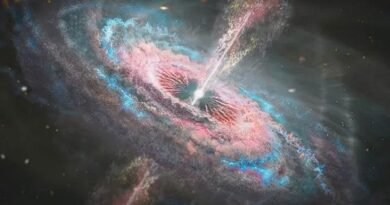Scientists Generate 5 New Isotopes to Study Neutron Star Collisions

Scientists synthesize 5 new isotopes to investigate the process of gold formation during neutron star collisions.
Researchers have successfully synthesized five novel isotopes with potential implications for understanding stellar collisions and the creation of heavy elements like gold and silver. These isotopes—Thulium-182, Thulium-183, Ytterbium-186, Ytterbium-187, and Lutetium-190—have been artificially created for the first time on Earth at the Facility for Rare Isotope Beams (FRIB) at Michigan State University (MSU).
The significance of this achievement lies in its potential to shed light on the processes occurring in the extreme environments surrounding merging neutron stars. These isotopes, crucial for astrophysics, offer a glimpse into realms previously inaccessible to scientific inquiry.
Each element on the periodic table is characterized by the number of protons in its nucleus, but isotopes of an element can have varying numbers of neutrons. The five newly synthesized isotopes are particularly remarkable because they have never been observed on Earth before.
According to Bradley Sherrill, University Distinguished Professor at MSU, this is likely the first instance of these isotopes being present on the Earth’s surface. The synthesis of these isotopes represents a significant milestone, akin to embarking on an exploratory journey into uncharted territories.
In the grand cosmic scheme, stars act as celestial forges, synthesizing elements through nuclear fusion processes. While massive stars can forge elements up to iron, the formation of heavier elements necessitates extraordinary circumstances, such as the violent collision of neutron stars.
When massive stars reach the end of their lifecycle, they collapse, leading to the formation of neutron stars or black holes. In binary neutron star systems, the eventual collision generates intense gravitational waves and ejects neutron-rich matter—a crucial ingredient for the synthesis of heavy elements like gold.
The rapid capture process, facilitated by free neutrons released during these collisions, contributes to the formation of unstable superheavy isotopes. These isotopes, though fleeting, decay into stable elements, potentially including gold.
The creation of Thulium-182, Thulium-183, Ytterbium-186, Ytterbium-187, and Lutetium-190 on Earth represents a significant step towards understanding the processes involved in the synthesis of heavy elements. Beyond astrophysics, these findings hold implications for nuclear physics research.
Published in the journal Physical Review Letters, this research paves the way for further investigations into the properties and behavior of these newly synthesized isotopes, offering valuable insights into the mysteries of the cosmos and the fundamental nature of matter.








